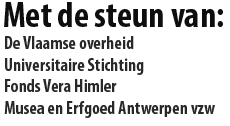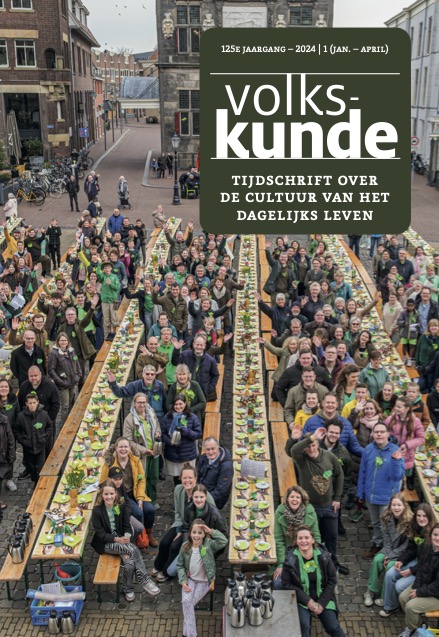125e JAARGANG – Nummer 1 (2024)
‘What are you doing?’ An exploration of local heritage communities in the context of the Faro Convention
Wim Burggraaf & Sophie Elpers
For the implementation of the Faro Convention, which the Netherlands recently signed, it is essential to understand the occurrence and dynamics of heritage communities. On the one hand, to have a picture of community support that is important for policymaking around the Convention and, on the other, to enable heritage professionals to rely on it in their participatory work.
The contribution describes an exploration of 75 local heritage communities in the city of Gouda and provides insights into the dynamics of the identified communities. The ethnographic methodology used focusses on the practices through which people of different cultural backgrounds and ages shape heritage communities. These concern heritage communities around tangible, intangible and natural heritage that can be divided into nine categories: history and archaeology, objects and collections of objects, monuments, green environment, festivals and rituals, performing arts and oral culture, crafts and special knowledge/skills, culinary culture, sports, and gaming. It is essential to be alert to the dynamic and heterogeneous nature of these communities when using the concept of ‘heritage community’. An open and reflexive attitude, with attention to multi-perspectivism, remains crucial.
The Peasant’s War in context. 225 years of facts and creation of an image
Christoph De Spiegeleer
This essay takes the representation of the so-called ‘Peasants’ War’ in the popular documentary series Het Verhaal van Vlaanderen (2023) as a starting point to place the sequence of events in the Southern Netherlands during the 1798 war in a nuanced historical perspective. The main findings of a recent academic colloquium on the Peasants’ War serve as our guideline (‘De Boerenkrijg in context’, 7/10/2023, Sint-Niklaas). A political-historical perspective on the 1798 rebellion against the French occupation should consider both the foreign policy of the regime of the Directory and the local difficulties that the French regime faced in implementing its socio-economic, military, and anti-clerical policies. From a socio-historical perspective, the Peasants’ War was far from an isolated phenomenon in Europe. To unravel the complex interplay of factors that caused the rebellion, we must compare the so-called “Belgian Vendée” with other rural uprisings, from both a long-term and an international perspective. The modern political and cultural use of the memory of the Peasants’ War along the linguistic and philosophical fault lines in Belgium is a rich field of study for historians and modern ethnologists alike. For a long period of time, the Peasants’ War provided in Flanders a site of collective memory transmitted through songs, stories, monuments and other forms of (im)movable and immaterial heritage. 225 years after the events, in current-day Flanders, however, the 1798 rebellion offers inspiration for folklorist and celebratory practices in only a handful of places.
Curating War. How to collect, manage and share war as heritage in a war museum?
Els Veraverbeke
There are many museums in Belgium and worldwide about the First World War. But how do you deal with the theme of war, conflict and violence as a museum? How do you curate war in a museum collection? The In Flanders Fields Museum has a unique position as a nationally recognized museum about the First World War in Belgium, as it is not embedded in a broader military museum or national-historical context. The museum is about people who make and experience war. This human perspective is central to the museum. War is an integral aspect of every individual’s daily life. This vision determines the entire heritage operation in the In Flanders Fields Museum, including the collection policy. Often the material piece an sich is not the most important, but tangible memories of stories, events and emotions. War heritage is not only tangible. The Ypres Cloth Halls and the surrounding landscape bear witness to the impact of war. Even today, there are numerous commemorations and ceremonies to remember the many victims of the First World War.
The topic of war heritage encompasses not only the past but also the present and future approach to the past. Besides curating war as a museum, the war past is also curated by society and societies.
Commemorative practices around World War I are numerous, in Belgium and worldwide. Many times a commemoration focuses on a person or a group. How do you deal with the (re)presentation of these practices in a museum context and still want to be inclusive and multi-voiced? As a museum, In Flanders Fields assumes a role in the landscape of commemoration and is an actor in numerous pilgrimages. This creates a remarkable position as a museum, as a staff member. How do you handle it? The museum not only wants to be a place where commemorative practices are collected, researched and interpreted, but also really wants to encourage the public to experience commemorative rituals. The museum is also involved (co-)organizer in numerous practices and wants to further pursue this in the future around the commemoration of civilian victims.
It can be relevant to connect current World War I commemoration practices in our country with contemporary war stories, but finding the right tone, content, and added value is not evident and not without danger. This should not be optional. This is a priority for World War I museums internationally.
Folktale Database of the Low Countries
Theo Meder
In March 2024, two Dutch-language folktale databases have merged and now contain more than 100,000 folktales from the Netherlands and Flanders. Although the Flemish Folktale Database can still be consulted online on a server of the University of Leuven, the collection has not been maintained or supplemented for almost 20 years: seehttps://www.volksverhalenbank.be/
The Dutch Folktale Database is now called Folktale Database of the Low Countries and is still being updated at the Meertens Instituut in Amsterdam: see https://www.verhalenbank.nl/
A Plea for Heritage Education
Jan Pandelaers
Heritage is present in the daily lives of young people and can help them in their development. But how do we make them aware of this heritage?
The classic heritage question “What do we want to preserve and pass on to the next generation?” is radically reversed in this article: “What do young people want to inherit from us?”
Young people today are worried about many issues: climate, safety (both physical and mental), tolerance, education… Heritage can create a framework for dialogue on these current themes. Heritage education is a two-way street, even when working with young people.
Heritage can offer young people “pedagogical places” where we do not tell them what they should be able to do or what they should do, but where we present the world to them in a way that appeals to them. In this way, we can allow their interests to blossom, they gradually find their place and shape their identity.
Heritage education is not about telling them how much better things were in the past. It is about making the link between the past and the challenges of today. The stories of connectedness and solidarity in a village or neighbourhood can help you to be rooted in a living community. Traditional local production and economy reduce your ecological footprint. Learning to deal with contested heritage can defuse current tensions and cultural differences.
Heritage education that starts from the living environment of children and young people will have a much greater impact and be much more relevant to their upbringing.
ISEBEL and Dragonlore
Theo Meder
Folktale researchers would like to know more about the history, distribution and meaning of certain traditional legends and their motifs, for instance about trolls or gnomes, but how do you get that international legend material, in all those different languages, together for comparative research? ISEBEL can offer a solution: the acronym stands for Intelligent Search Engine for Belief Legends. It is an international search engine that makes it possible to search in English. So far, almost 90,000 legends have been harvested in ISEBEL in Dutch, Frisian, German, Danish and Icelandic. As an example of how ISEBEL works, the focus here will be on the search for dragons.
Finding fairies in ISEBEL. Research on culture exceeding themes in Fairy Folklore
Myrthe Osse
Fairies are a prominent aspect of the folklore of many European countries. The current three-part framework for categorizing fairy folklore posited by Katherine M. Briggs is well suited for the research into British fairy folklore, but is not always applicable to fairy folklore in the rest of North-West Europe. This study aims to enhance the pre-existing three-part framework by providing an insight into the common themes found in fairy folklore throughout North-West Europe, and to uncover shared themes in these folktales.
The medieval chair of Saint Lutgardis in Borgloon. A state of affairs
Jeroen Reyniers
An ancient chair is displayed to churchgoers at St. Odulphus Church in Borgloon, Belgium. This chair is considered the oldest piece of seating furniture in Belgium, dating back to around 1200. It is a relic because it is believed to have been used by Saint Lutgardis of Tongeren (1182-1246) when she was a nun at the St. Catherine’s Monastery in Sint-Truiden. The chair has survived many wars and difficult times in the Sint-Truiden area, leading it to end up in various places over the years. Today, the chair is primarily known as a fertility object. Frequently, (young) women with an unfulfilled desire to have children sit on it and ask Saint Lutgardis for help. The article provides an update on the research of this object, briefly touching on the chair’s history and the tradition of longing for parenthood. A bibliography is included, summarizing previous research and the chair’s recognition through various channels.


